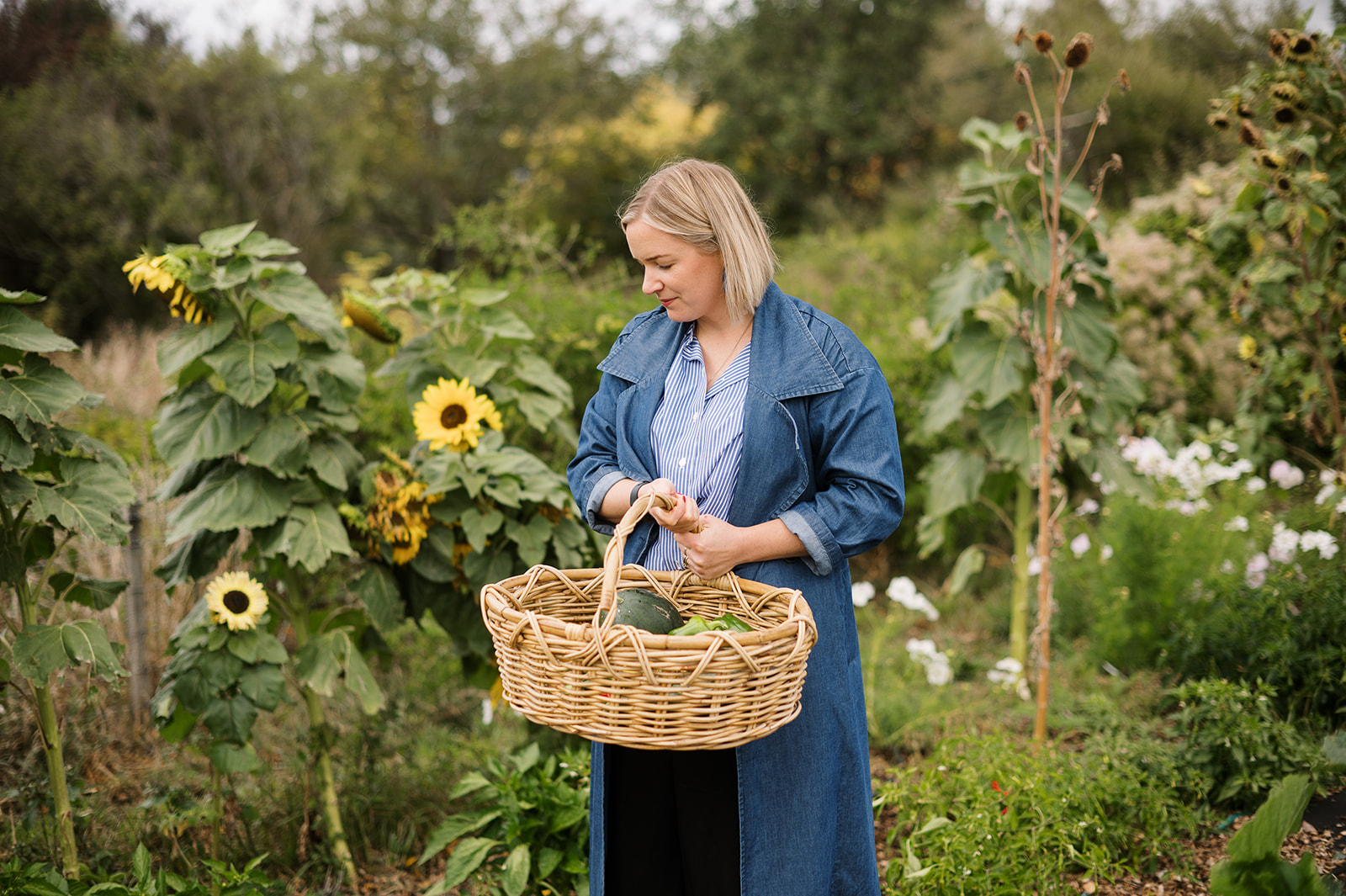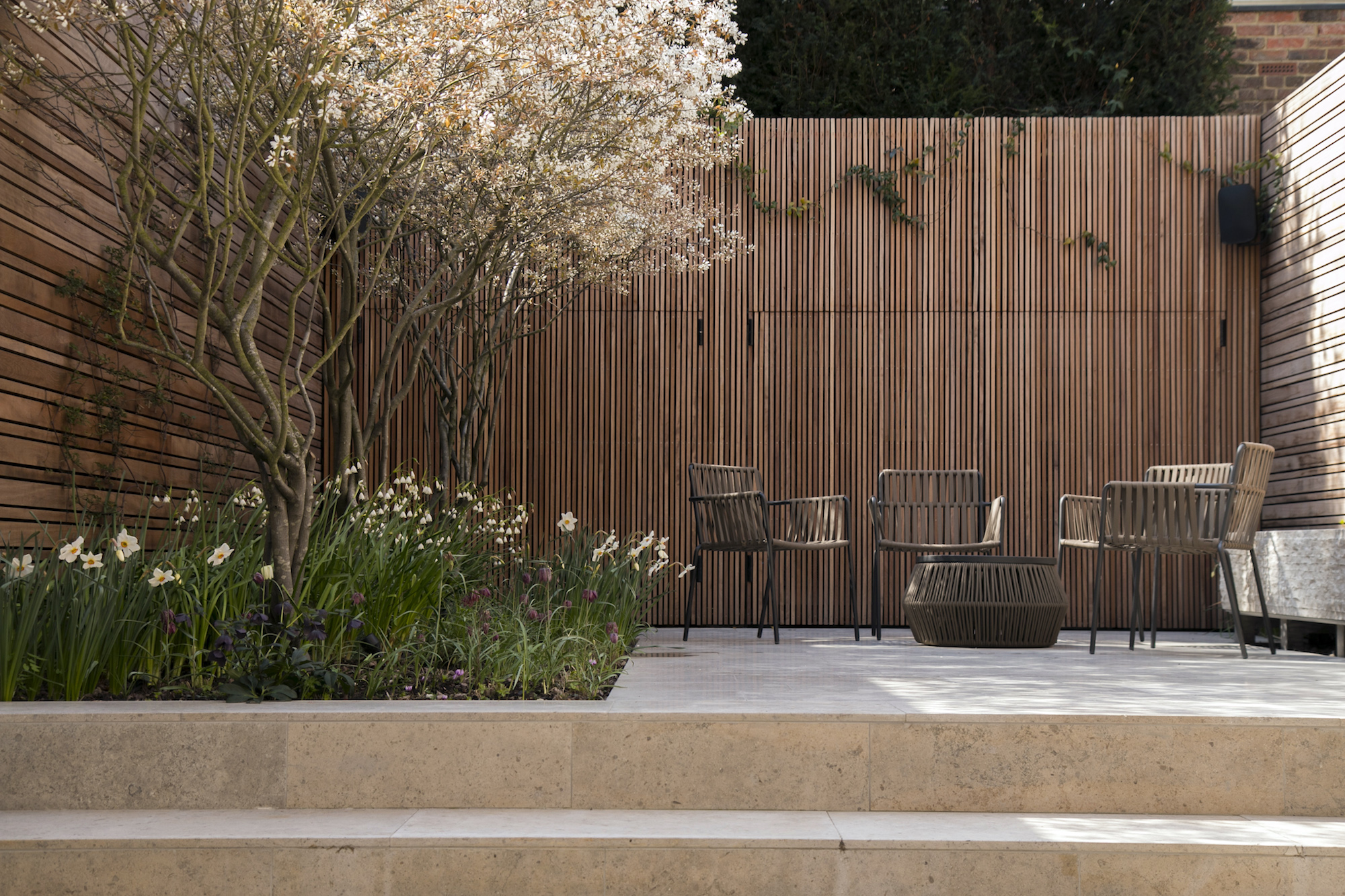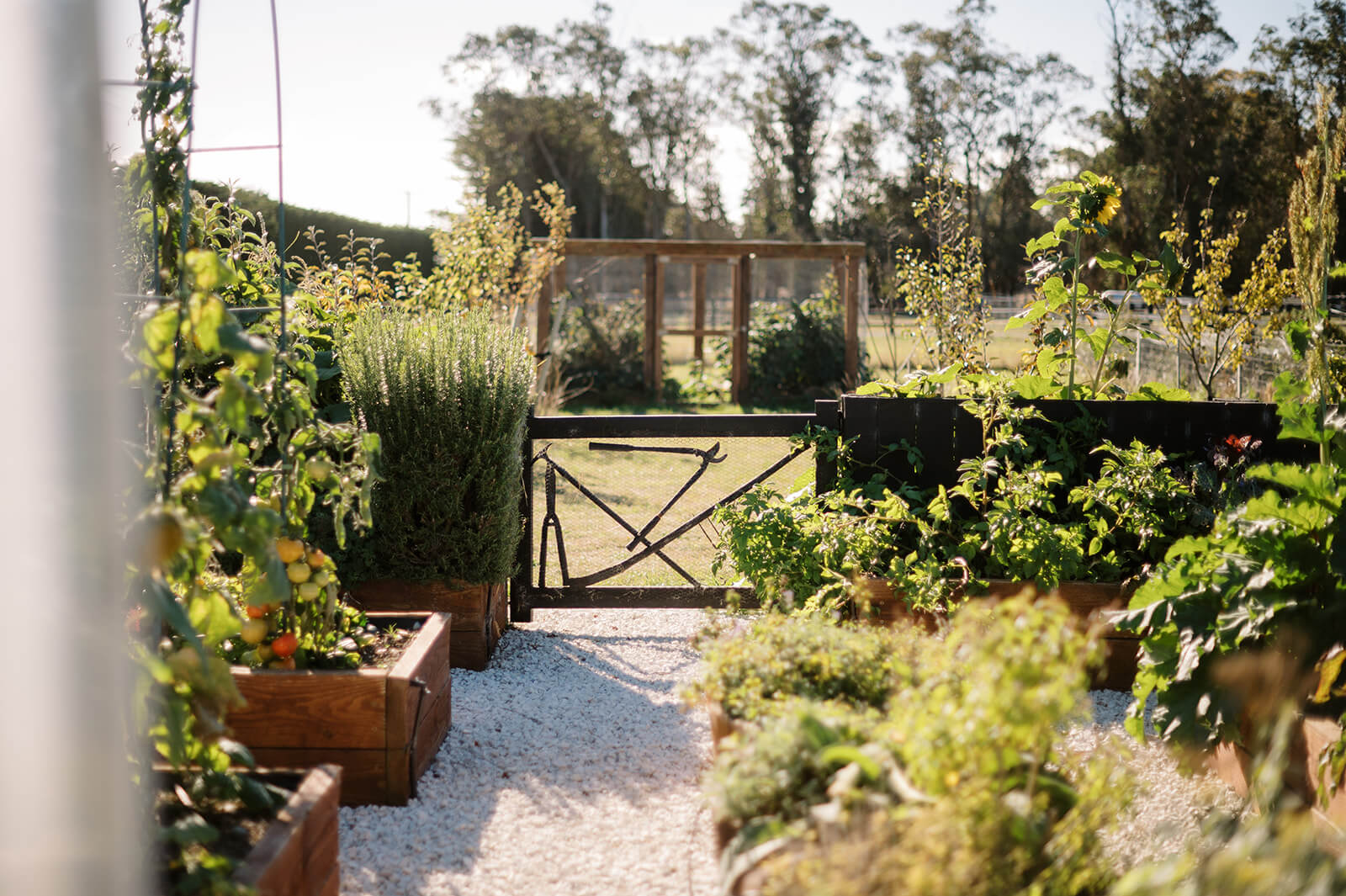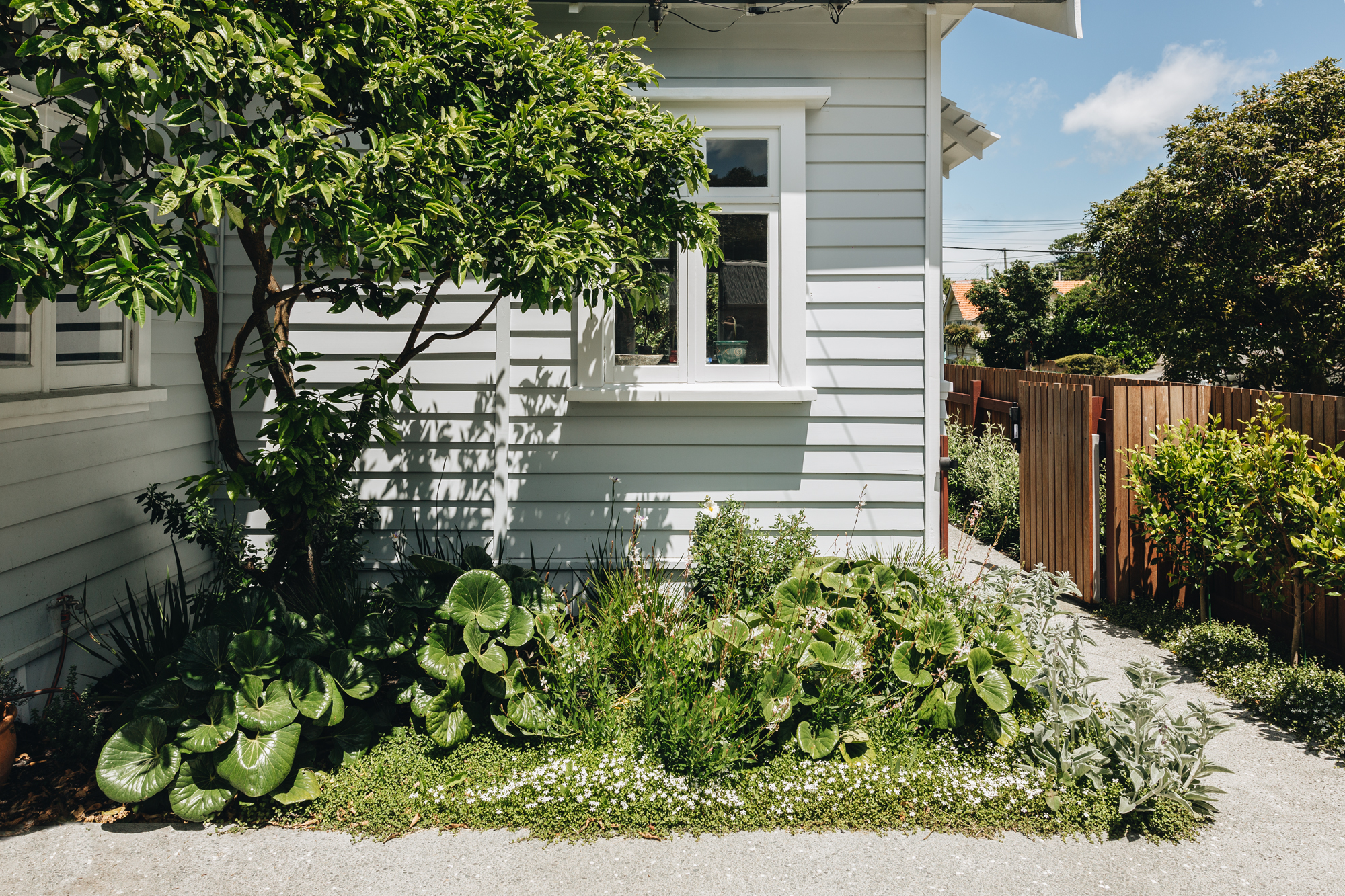A story brought to you in partnership with Goodnature.
In the North Canterbury country town of Amberley, amid rural landscapes and a close-knit community, reside Keeley and Jen Pomeroy – two garden enthusiasts whose journey into gardening reflects a deep-rooted connection to family, food and community.
The couple, their two children, adopted Greyhound Queenie and Blue Heeler pup Roy Pomeroy, moved from central Christchurch out to Amberley two years ago. Their move from city to rural life wasn’t merely for a change of scenery — it was a quest for more space to cultivate their passion for growing their own food, and to discover a real sense of community.

Jen & Keeley Pomeroy in their North Canterbury garden.
For Keeley, whose upbringing was steeped in a family of hospitality and food connoisseurs, gardening takes him back to his childhood memories of his grandad’s garden in Woolston, Christchurch.
In those days, growing vegetables wasn’t just a hobby — it was a way of life. Reflecting on those times, Keeley shares how his grandad managed to supply about 80% of his household’s vegetable needs from his own backyard. Think: full beds of potatoes, onions, garlic.
However, in today’s world of off-the-shelf food options and restaurant cuisine, most of us have embraced a wider palette of food. This is reflected in the Pomeroy’s garden today, where they grow beyond the basics. Experimenting with hybrid fruits like nashi pears and exotic citrus varieties like finger limes and yuzu lemons.


The focus of Jen and Keeley’s garden is edibles. With over 50 fruit trees planted in the past two years, a berry enclosure and two ever-expanding garden plots, they’ve transformed much of their 2,400 square metre section into an edible paradise.
Though they embrace this ethos of sustainability without adding the pressure of complete self-sufficiency. “We know how much it is to be fully self-sufficient, and that’s not our goal. But we want to be part of the way there.” says Jen.
Jen, a trained chef turned entrepreneur, uses her culinary expertise to harvest and create seasonal dishes with a ‘veggie forward’ approach. Jen runs a seasonal recipe membership called The Modern Mess, where she develops three flavour-packed recipes per week for her members. With her own garden producing so much, she keeps her finger on the pulse as to exactly what’s in season, and how best to serve it up to her members.
Having well-outgrown their garden at their home in the city, Keeley and Jen sought out more space and a community they could partake in in Amberley. The expansive backyards in the small town offered them the blank canvas they wanted. “Basically, we wanted more garden, because we’d gardened the heck out of the last house,” Jen quips.





Aside from gardening, Keeley has another hobby – spearfishing – which intertwines seamlessly with Jen’s skills as a chef. Keeley’s journey into spearfishing stemmed from a desire for a new hobby — one that would provide not only enjoyment but also a practical way to bring home food for the family. But it’s not just about the catch for Keeley, it’s about the camaraderie forged with fellow enthusiasts.
Joining the local spearfishing club opened doors to a community of like-minded hunter-gatherers. Recently, the club embarked on a trip to D’Urville Island. In preparation for the trip, Jen curated a mouthwatering menu of condiments and accompaniments to send along with Keeley to complement their kaimoana haul. From sashimi dressing to curry to pasta sauce, every delicious dish highlighted the simple joys of sharing a freshly prepared meal with others.


The Pomeroys don’t just garden to grow food and create beautiful meals for themselves and others – it’s also a reflection of their values and aspirations. Their garden is a sanctuary — a place where they can destress from the pressures of life and reconnect with nature. “We have incredible night skies out here. When the sun is casting off the Southern Alps, I can take a deep breath and everything feels ok.” Keeley reflects.
From the hard work they’ve put into their homegrown garden, the Pomeroys have forged connections with the land, with each other and with their local community. A reminder that sometimes, the most meaningful journeys begin right in our own backyard.
Related reading: Miso creamed corn & kimchi toastie by Jen Pomeroy


Keeley & Jen’s seasonal garden changes & challenges:
Autumn —
Looking ahead, Keeley and Jen are gearing up for the winter transition. Having sown seeds for brassicas and winter vegetables in early March, they are busy planting out the seedlings now. They’re also getting their garlic and broad beans in the ground.
Like any garden, theirs isn’t without its challenges. Through summer, they’ve grappled with pesky psyllids wreaking havoc on their tomatoes, dashing their hopes of a pantry stocked with homemade tinned tomatoes. (Next year they’ll cover their potatoes and tomatoes with psyllid-proof cloth to try and help with this!) And by early autumn the pumpkin patches had succumbed to powdery mildew.
Lack of rain was a particular issue this summer, with plants not getting enough water and local water restrictions being set. Now, in autumn, they are wanting to crack on with their autumn garden jobs, but the ground is too hard to break ground.

Powdery mildew is a garden challenge for the Pomeroys

Drought has been another big challenge this season for Canterbury growers.
And in terms of furry pests, as things start to cool down, they have caught several mice in their roof space with their Goodnature Smart Trap. This autumn they have noticed, for the first time, something nibbling at their pumpkins. And after a kitten-sized rat turned up dead on their property, they’ve set another couple of traps up outside!
They know autumn is the time to get the traps out. With chickens (and a burrow hole spotted under the chicken house!) and a thriving compost bin, they need to be extra vigilant.
Jen & Keeley are using a Goodnature Smart Trap around the chook house, for rats and hedgehogs, and in the ceiling for mice. They’re using Goodnature Professional Kit for where they have recently harvested a garden full of sunflowers, knowing the seeds will be enticing for rodents! They also use a post-mounted possum trap for the occasional possum.
–
“Fruit trees and berry patches are like magnets for rats and mice, and who can blame them – they’re delicious! As Jen and Keeley are probably learning, it’s impossible to keep a big thriving food garden totally pest free. There’s just too much incredible food attracting them, especially at harvest time. I always suggest people find a balance between protecting their hard-earned harvest, and accepting that nature will always find a way to help themselves to some of it. In a big garden like Jen and Keeley’s I’d recommend two or three good-quality traps, that can be easily moved around the garden, so as the rats and mice move, so can your traps.”
– Craig Bond, Goodnature Co-founder





This article was brought to you by Goodnature.
A little about Goodnature, and why we support their kaupapa
Born out in the New Zealand bush, Goodnature’s revolutionary traps are toxin-free, built to last, a pleasure to use and respectful to the pests they kill. They’re big believers that less pests equals more nature, and with almost half a million Goodnature traps in homes, backyards, forests and farms around the world, that belief is becoming reality one pest at a time.
Words by Emma Sage | Photography by Natalie McNally






